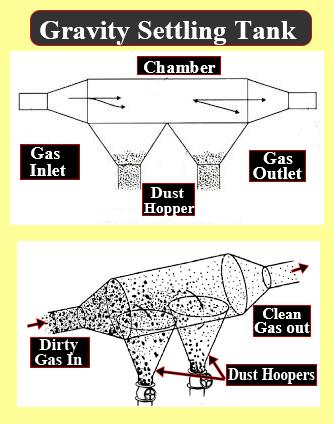Answer
394.5k+ views
Hint: Gravity settling tanks are equipment that relies on various fields of forces like gravitational, centrifugal, and electric. The usual velocity used through the settling chamber is between 0.5 to 2.5 m/s. The size of the particles that can be removed using gravity settling tanks is more than about 20 times the maximum velocity used within them.
Complete answer:
Gravity settling tanks/porous filters are used to remove particles larger than 50μm. Settling is a process by which particles settle to the bottom of a liquid and form sediment. Particles experience a force either in the form of gravity or due to centrifugal motion. As a result, they tend to move in a uniform manner in the direction exerted by that force. In ‘gravity settling’ the particles tend to fall to the bottom of the vessel resulting in the formation of a slurry at the vessel base.
Now let us learn about settling tanks. Gravity separation involves settling tanks, tube settlers, and hydro cyclones. Filtration includes screen, granular media, or porous media filter. Flotation constitutes foam fractionation. Gravitational settling chambers are usually used to remove abrasive particles larger than 50 μm.
Additional Information: Advantages of settling tanks or basins:
-It involves the simplest of technologies.
-There is little energy input required.
-It is a relatively inexpensive feature to install and operate.
So, the correct answer is, ‘ 50 μm.’
Note: -Gravity settling tanks are also known as settling basins.
-Settling basins or settling tanks are containers created for the removal of entrained solids.
-The settling behavior of heavier particles is often affected by the turbulence, flow surges, and wind shear.
-Gravitational settling tanks provide large areas to minimize horizontal velocities and let the vertical velocity carry the particle to the floor.

Complete answer:
Gravity settling tanks/porous filters are used to remove particles larger than 50μm. Settling is a process by which particles settle to the bottom of a liquid and form sediment. Particles experience a force either in the form of gravity or due to centrifugal motion. As a result, they tend to move in a uniform manner in the direction exerted by that force. In ‘gravity settling’ the particles tend to fall to the bottom of the vessel resulting in the formation of a slurry at the vessel base.
Now let us learn about settling tanks. Gravity separation involves settling tanks, tube settlers, and hydro cyclones. Filtration includes screen, granular media, or porous media filter. Flotation constitutes foam fractionation. Gravitational settling chambers are usually used to remove abrasive particles larger than 50 μm.
Additional Information: Advantages of settling tanks or basins:
-It involves the simplest of technologies.
-There is little energy input required.
-It is a relatively inexpensive feature to install and operate.
So, the correct answer is, ‘ 50 μm.’
Note: -Gravity settling tanks are also known as settling basins.
-Settling basins or settling tanks are containers created for the removal of entrained solids.
-The settling behavior of heavier particles is often affected by the turbulence, flow surges, and wind shear.
-Gravitational settling tanks provide large areas to minimize horizontal velocities and let the vertical velocity carry the particle to the floor.

Recently Updated Pages
Basicity of sulphurous acid and sulphuric acid are

What is the stopping potential when the metal with class 12 physics JEE_Main

The momentum of a photon is 2 times 10 16gm cmsec Its class 12 physics JEE_Main

Using the following information to help you answer class 12 chemistry CBSE

Which of the following would not be a valid reason class 11 biology CBSE

Why should electric field lines never cross each other class 12 physics CBSE

Trending doubts
Difference Between Plant Cell and Animal Cell

Difference between Prokaryotic cell and Eukaryotic class 11 biology CBSE

Fill the blanks with the suitable prepositions 1 The class 9 english CBSE

Change the following sentences into negative and interrogative class 10 english CBSE

Summary of the poem Where the Mind is Without Fear class 8 english CBSE

Give 10 examples for herbs , shrubs , climbers , creepers

Write an application to the principal requesting five class 10 english CBSE

What organs are located on the left side of your body class 11 biology CBSE

What is the z value for a 90 95 and 99 percent confidence class 11 maths CBSE



